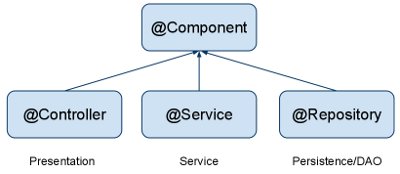What's the difference between @Component, @Repository & @Service annotations in Spring?
@Component is equivalent to
<bean>@Service, @Controller , @Repository = {@Component + some more special functionality}
That mean Service,Controller and Repository are functionally the same.
The three annotations are used to separate "Layers" in your application,
- Controllers just do stuff like dispatching, forwarding, calling service methods etc.
- Service Hold business Logic, Calculations etc.
- Repository are the DAOs(Data Access Objects), they access the database directly.
Now you may ask why separate them:(I assume you know AOP-Aspect Oriented Programming)
Lets say you want to Monitors the Activity of the DAO Layer only. You will write an Aspect(A class) class that does some logging before and after every method of your DAO is invoked, you are able to do that using AOP as you have three distinct Layers and are not mixed.
So you can do logging of DAO "around", "before" or "after" the DAO methods. You could do that because you had a DAO in the first place. What you just achieved is Separation of concerns or tasks.
Imagine if there were only one annotation @Controller, then this component will have dispatching, business logic and accessing database all mixed, so dirty code!
Above mentioned is one very common scenario, there are many more use cases of why to use three annotations.
In Spring @Component, @Service, and @Controller. @Component are Stereotype annotations which is used for:
@Controller: where your request mapping from presentation page done i.e. Presentation layer won't go to any other file it goes directly to @Controller class and check for requested path in @RequestMapping annotation which written before method calls if necessary.
@Service: All business logic is here i.e. Data related calculations and all.This annotation of business layer in which our user not directly call persistence method so it will call this methods using this annotation. It will request @Repository as per user request
@Repository:This is Persistence layer(Data Access Layer) of application which used to get data from database. i.e. all the Database related operations are done by repository.
@Component - Annotate your other components (for example REST resource classes) with component stereotype.

From Spring Documentation:
In Spring 2.0 and later, the @Repository annotation is a marker for any class that fulfills the role or stereotype (also known as Data Access Object or DAO) of a repository. Among the uses of this marker is the automatic translation of exceptions.
Spring 2.5 introduces further stereotype annotations: @Component, @Service, and @Controller. @Component is a generic stereotype for any Spring-managed component. @Repository, @Service, and @Controller are specializations of @Component for more specific use cases, for example, in the persistence, service, and presentation layers, respectively.
Therefore, you can annotate your component classes with @Component, but by annotating them with @Repository, @Service, or @Controller instead, your classes are more properly suited for processing by tools or associating with aspects. For example, these stereotype annotations make ideal targets for pointcuts.
Thus, if you are choosing between using @Component or @Service for your service layer, @Service is clearly the better choice. Similarly, as stated above, @Repository is already supported as a marker for automatic exception translation in your persistence layer.
| Annotation | Meaning |
+------------+-----------------------------------------------------+
| @Component | generic stereotype for any Spring-managed component |
| @Repository| stereotype for persistence layer |
| @Service | stereotype for service layer |
| @Controller| stereotype for presentation layer (spring-mvc) |Spring 2.5 introduces further stereotype annotations: @Component, @Service and @Controller. @Component serves as a generic stereotype for any Spring-managed component; whereas, @Repository, @Service, and @Controller serve as specializations of @Component for more specific use cases (e.g., in the persistence, service, and presentation layers, respectively). What this means is that you can annotate your component classes with @Component, but by annotating them with @Repository, @Service, or @Controller instead, your classes are more properly suited for processing by tools or associating with aspects. For example, these stereotype annotations make ideal targets for pointcuts. Of course, it is also possible that @Repository, @Service, and @Controller may carry additional semantics in future releases of the Spring Framework. Thus, if you are making a decision between using @Component or @Service for your service layer, @Service is clearly the better choice. Similarly, as stated above, @Repository is already supported as a marker for automatic exception translation in your persistence layer.
@Component – Indicates a auto scan component.
@Repository – Indicates DAO component in the persistence layer.
@Service – Indicates a Service component in the business layer.
@Controller – Indicates a controller component in the presentation layer.
reference :- http://static.springsource.org/spring/docs/3.0.0.M3/reference/html/ch04s12.html
http://stackoverflow.com/questions/25633477/security-configuration-with-spring-boot?rq=1
What's the difference between @Component, @Repository & @Service annotations in Spring?的更多相关文章
- [转]what’s the difference between @Component ,@Repository & @Service annotations in Spring
原文地址:https://www.cnblogs.com/softidea/p/6070314.html @Component is equivalent to <bean> @Servi ...
- 【转载】@Component, @Repository, @Service的区别
@Component, @Repository, @Service的区别 官网引用 引用spring的官方文档中的一段描述: 在Spring2.0之前的版本中,@Repository注解可以标记在任何 ...
- SpringAnnotation注解之@Component,@Repository,@Service,@Controller
@Component:组件,表示此写上了此注解的bean,作为一个组件存在于容器中.这样的话别的地方就可以使用@Resource这个注解来把这个组件作为一个资源来使用了.初始化bean的名字为类名首字 ...
- @Component @Repository @Service @Controller
Spring 2.5 中除了提供 @Component 注释外,还定义了几个拥有特殊语义的注释,它们分别是:@Repository.@Service 和 @Controller.在目前的 Spring ...
- @Component, @Repository, @Service的区别
注解 含义 @Component 最普通的组件,可以被注入到spring容器进行管理 @Repository 作用于持久层 @Service 作用于业务逻辑层 @Controller 作用于表现层(s ...
- @Component, @Repository, @Service,@Controller的区别
@Component, @Service, @Controller, @Repository是spring注解,注解后可以被spring框架所扫描并注入到spring容器来进行管理 @Componen ...
- 从头认识Spring-2.7 自己主动检測Bean(1)-@Component @Repository @Service @Controller
这一章节我们来讨论一下自己主动检測Bean. 1.domain 厨师类: package com.raylee.my_new_spring.my_new_spring.ch02.topic_1_19; ...
- @Component @Controller @Service @Repository@Resourse
@Component @Controller @Service @Repository@Resourse这些全部是Spring提供的注解. 其中@Component用来表示把一个类纳入spring容器 ...
- Spring注解详解@Repository、@Component、@Service 和 @Constroller
概述 注释配置相对于 XML 配置具有很多的优势: 它可以充分利用 Java 的反射机制获取类结构信息,这些信息可以有效减少配置的工作.如使用 JPA 注释配置 ORM 映射时,我们就不需要指定 PO ...
随机推荐
- iOS开发-导出profile文件
1.登陆苹果开发者网站 苹果开发者中心,点击 Certificates, Identifiers & Profiles 2.导出Provisioning Profiles 2.1 点击右上脚加 ...
- ubuntu 16.4安装toolsbelt heroku
https://devcenter.heroku.com/articles/getting-started-with-python#set-up # Run this from your termin ...
- Python3 + django2.0 + apache2 + ubuntu14部署网站上线
自己尝试在本地搭建了 Django 项目后,想部署到自己云服务器上,经常多次尝试和多次踩坑(捂脸),总结如下: 环境:ubuntu14, django2.0, apache2. 1.首先安装需要的库包 ...
- loj #6201. 「YNOI2016」掉进兔子洞
#6201. 「YNOI2016」掉进兔子洞 您正在打galgame,然后突然发现您今天太颓了,于是想写个数据结构题练练手: 给出一个长为 nnn 的序列 aaa. 有 mmm 个询问,每次询问三个区 ...
- 洛谷P4494 [HAOI2018]反色游戏(tarjan)
题面 传送门 题解 我们先来考虑一个联通块,这些关系显然可以写成一个异或方程组的形式,形如\(\oplus_{e\in edge_u}x_e=col_u\) 如果这个联通块的黑色点个数为奇数,那么显然 ...
- 洛谷P3358 最长k可重区间集问题(费用流)
传送门 因为一个zz错误调了一个早上……汇点写错了……spfa也写错了……好吧好像是两个…… 把数轴上的每一个点向它右边的点连一条边,容量为$k$,费用为$0$,然后把每一个区间的左端点向右端点连边, ...
- MySQL索引的索引长度问题
转自:http://samyubw.blog.51cto.com/978243/223773 MySQL的每个单表中所创建的索引长度是有限制的,且对不同存储引擎下的表有不同的限制. 在MyISAM表中 ...
- SQL语句之表操作
SQL语句系列 1.SQL语句之行操作 2.SQL语句之表操作 3.SQL语句之数据库操作 4.SQL语句之用户管理 写在前面 在上一篇博文里面我整理了“行”级别的操作,分别是“增(insert).删 ...
- OC语法
``` int main(int argc, const char * argv[]) { @autoreleasepool { // insert code here... NSString *S= ...
- n阶幻方
前序 最近在学习一些经典的算法,搞得头昏脑涨,就想换换脑子.在家里的旧书堆里面乱翻,无意中将一本具有十多年历史的小学数学奥林匹克竞赛的书发掘了出来,能放到现在挺不容易的,就拿起来随便翻翻.看了看目录, ...
